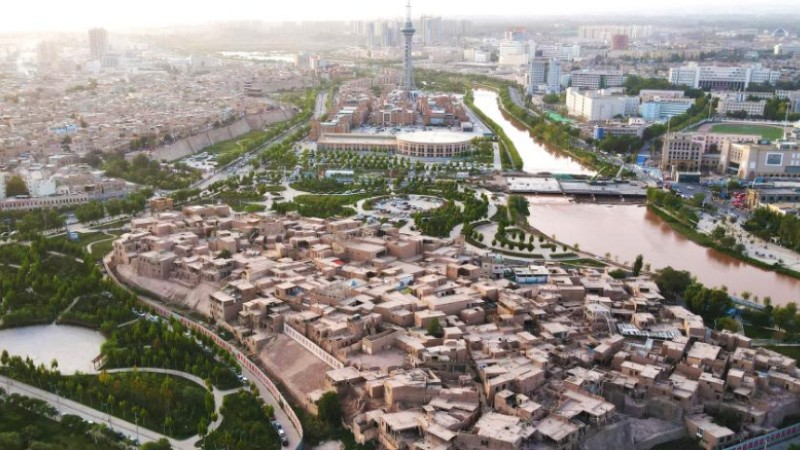Experts, officials pool wisdom for developing ecological highlands in Tibet
LHASA, Sept. 11 (Xinhua) -- More than 100 academics and government officials gathered on Sunday in southwest China's Tibet Autonomous Region for the Namjagbarwa forum held in Nyingchi City.
Nyingchi is home to the towering Mount Namjagbarwa, which stands at 7,782 meters above sea level.
Situated on the Qinghai-Tibet Plateau, known as "the roof of the world" and "the water tower of Asia," Tibet plays a pivotal role in ensuring China's environmental security. The Chinese government has consistently attached great importance to eco-environmental protection in Tibet.
Tibet's ecosystems are now generally stable. Environmental quality is improving, supported by a green development model, and the protection of eco-environmental rights and interests has been strengthened. Today, Tibet boasts one of the best eco-environments in the world.
In November 2021, the regional government made a strategic decision to develop ecological highlands in Tibet and lead the way in building an ecological civilization. During the two-day forum, attendees engaged in discussions regarding the progress, opportunities and challenges associated with this endeavor.
Dorji, an academician from the Chinese Academy of Engineering, called for scientific development and utilization of renewable and clean energy to support the goal.
"Tibet has abundant clean and renewable energy sources, such as hydropower, solar energy, geothermal energy and wind energy. These are unique advantages to build the region into a highland of ecological civilization," he said, adding Tibet should accelerate the development of the green energy industry.
Tibet is working to develop itself into a national clean energy base. By 2020, clean energy had contributed 89.1 percent of the installed power-generating capacity in the region.
Dorji noted that diversified energy sources have changed the production and lifestyle of the locals. "An increasing number of farmers and herdsmen have used electricity produced by renewable energy, instead of burning firewood or cow dung, which can help reduce logging, greenhouse gas emissions and pollution, as well as improve their living standard."
He proposed the scientific and rational development of geothermal energy, emphasizing its significant potential, environmental advantages, renewability, safety, stability, high efficiency, affordability, versatility, and ease of use. Geothermal energy, he argued, stands out as one of the most competitive renewable resources due to these attributes.
"In addition to electricity generation, geothermal energy can also be used for the development of the health and wellness industry, thereby stimulating tourism, promoting rural revitalization, increasing local employment opportunities and boosting the income of the locals," he told Xinhua.
Wang Lei, an official of the Ministry of Natural Resources, said that constant efforts should be made to protect the ecology of the Qinghai-Tibet Plateau, with the ultimate goal of making it a national or even international ecological civilization highland.
"We need to strike a balance between high-quality development and high-level protection, reduce the ecological impact of resource development on the plateau, and promote Tibet's sustainable economic and social development," Wang added.
He also emphasized the necessity of strengthening ecological protection and restoration, with a focus on integrated protection and systematic management of mountains, rivers, forests, farmlands, lakes, grasslands, sands and glaciers, in an effort to enhance the diversity, stability and sustainability of the plateau's unique ecosystem.
Wang also highlighted the important role of technology in supporting the development of the national ecological civilization highlands in Tibet.
According to Chen Xinfeng, from the National Forestry and Grassland Administration, advancing the development of the nature reserve system based on national parks would play a positive role in the building of a national ecological civilization highland in Tibet.
In 2021, China officially designated the first group of five national parks, namely, the Sanjiangyuan National Park, the Giant Panda National Park, the Northeast China Tiger and Leopard National Park, the Hainan Tropical Rainforest National Park and the Wuyishan National Park.
"Significant progress has been achieved in the Tibet region since the Sanjiangyuan National Park was established. The ecosystem in the Yangtze River source areas has been comprehensively strengthened, and local residents have seen a significant increase in their income," Chen noted.
The region is now planning to open more national parks, which is expected to add weight to realize the goal of building the region into a national ecological civilization highland, he added.
Photos
Related Stories
- Tibet Story: Hillside village's eco-friendly garbage recycling cause
- Glaciers heat up tourism in Tibet
- China's Tibet achieves overall carbon neutrality
- China's Tibet attracts investment with optimized business environment
- Chinese political advisors discuss establishing mechanism for realizing value of ecological products
Copyright © 2023 People's Daily Online. All Rights Reserved.









